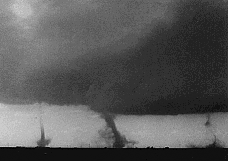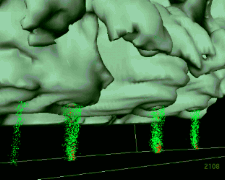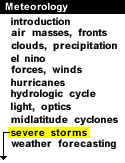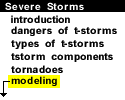
|
Even though supercell thunderstorms are responsible for the biggest and deadliest tornadoes, a significant number of tornadoes form under nonsupercell clouds and storms.
The left photograph below shows such an event. Notice that there are three tornadoes (there were actually five, but only three are pictured) that exist simultaneously. Modeling efforts to reproduce events like this have been successful as seen by the illustration below (right). Weightless tracer particles define the tornadoes.
 Photo by Blottman
Photo by Blottman
|
 Image by Lee
Image by Lee
|
These nonsupercell tornadoes (NST) are normally short-lived and weak, but from time to time can become strong enough to damage property and kill people. Because of this, researchers are investigating how a rotating entity like a tornado can be produced beneath clouds with non-rotating updrafts.
The visualization above shows the NST process. There is a strong change in the horizontal movement of air at the gust front located at the surface where the color changes. The resulting shearing instability leads to the formation of many tornadoes, some of which merge with one another. The yellow columns represent the rotation of the tornadoes.
Above is a closer look at the tornadoes produced in the previous animation. However, instead of marking the rotation regions in solid yellow, small weightless particles are introduced to show the wind field (red particles are sinking, green are rising).
These visualizations are from the first successful high resolution three-dimensional simulations of the NST generation process.





